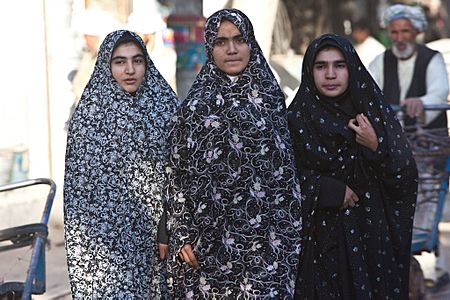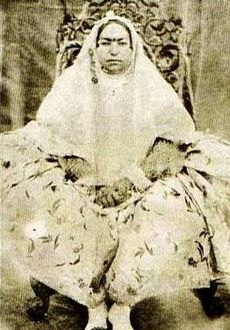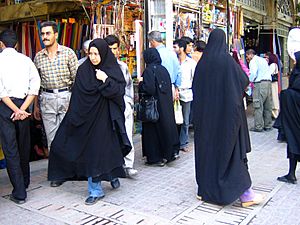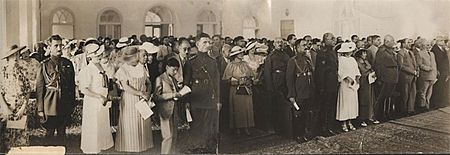Chador facts for kids

A chador (pronounced CHA-dor) is a long, open cloak worn by many women in Iran and some other countries. Women wear it in public or outdoors. It's like a large, full-body semicircle of fabric that opens down the front. A woman throws it over her head and then holds it closed in the front. The chador doesn't have buttons or clasps. Women usually hold it closed with their hands or tuck it under their arms.
Before the Iranian Revolution in 1978–79, black chadors were mostly used for funerals or times of sadness. For everyday wear, people used chadors made of light, printed fabrics. Today, most Iranian women who wear a chador use a black one when they are outside. They save light-colored chadors for wearing inside their homes.
Contents
History of the Chador
Ancient Times

Some historians believe that veiling, or covering the face, started in ancient Mesopotamia. There, wives and daughters of important noblemen had to wear veils. This showed their high social status. This custom was even controlled by special laws about clothing.
The ancient Achaemenid Empire in Persia (modern-day Iran) likely adopted this custom. A Greek historian named Plutarch wrote that Persian rulers kept their wives and concubines hidden from public view.
We don't have pictures of the chador itself from before Islamic times. However, the first pictures of a veil appear on sculptures from ancient Persia. The earliest written mention of the chador is in old Persian texts from the 6th century. It describes a head covering worn by Zoroastrian women.
It's thought that veiling continued through later Persian empires. It wasn't just for noble women; even Persian kings sometimes veiled themselves. Women in ancient Greece and the Byzantine Empire also stayed out of public view. European visitors in the 1700s and 1800s drew pictures of women wearing the chador and long white veils.
The Pahlavi Era
In the 20th century, the ruler of Iran, Reza Shah, banned the chador and all forms of Hijab in 1936. He wanted Iran to become more modern, like Western countries. Police would arrest women wearing veils and remove them by force.
This ban made many religious leaders and ordinary people very angry. For them, appearing in public without their head covering felt like being naked. However, some people, especially those who liked Western ideas, welcomed this change. They saw it as a step toward giving women more rights.
Later, the rules about dress became less strict. After Reza Shah left power in 1941, the forced removal of the veil stopped. But wearing a hijab was still seen as old-fashioned. It could make it harder for women to get good jobs or move up in society. Some fancy hotels and restaurants even refused to let women wearing chadors enter. Schools and universities also discouraged the chador. Girls from traditional families often wore a chador when leaving home, took it off at school, and put it back on for the trip home.
The Iranian Revolution
In April 1980, after the Iranian Revolution, new rules were made. Women working in government offices and schools had to wear a veil. By 1983, there were arguments about how strictly women should veil. This was called the "bad hijab" issue. Sometimes, there were even clashes with people who were thought to be wearing improper clothing.
The government decided to act. In July 1984, Tehran's public prosecutor announced stricter dress codes for public places. These included offices, theaters, clubs, hotels, and restaurants. In other places, people were expected to follow the dress style of most people. Stricter veiling meant wearing a chador or a looser khimar-type headscarf with a long overcoat.
How the Chador is Used Today

As mentioned, before the Iranian Revolution, black chadors were mostly for funerals. Light, printed fabrics were common for daily wear. Today, most women who wear the chador save light-colored ones for home or for prayers. Elderly women from rural areas are more likely to wear a light-colored chador outside in cities.
During the time of the Shah of Iran, many wealthy city women stopped wearing traditional clothes like the chador. They preferred modern Western clothing. However, women in smaller towns and villages continued to wear the chador. Traditionally, a light-colored or printed chador was worn with a headscarf (rousari), a blouse (pirahan), and a long skirt (daaman). Sometimes, women wore a blouse and skirt or dress over pants (shalvar). Many rural Iranian women, especially older ones, still wear these styles.
In Iran, wearing a chador does not always mean wearing a veil that covers the face. Inside the home, especially for women in cities, both the chador and face veil are often removed. Women and teenagers wear cooler, lighter clothes indoors. However, in modern times, rural women often continue to wear a light-weight printed chador over their clothes during their daily activities at home.
Some Iranian women wear the chador, whether they are Sunni or Shia Muslims. It is seen as a traditional Persian Iranian style. Iranians from other backgrounds might wear the chador or other traditional clothes. For example, Arab Iranian women in western and southern Iran often wear an overhead Abaya. This is similar to the Abaya worn in Iraq, Kuwait, and Bahrain.
Images for kids
-
"Statue of a Liberated Woman" showing a woman taking off her chador, in Baku, Azerbaijan
-
Women in Shiraz, Iran, 2019, wearing chadors
See also
 In Spanish: Chador para niños
In Spanish: Chador para niños




